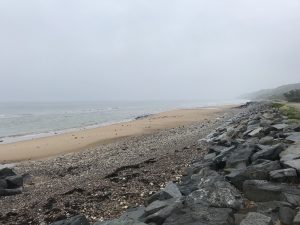I couldn’t help but think just how insurmountable the task at hand would have been for the thousands of soldiers that landed on the beaches of Normandy by air, by foot, by tank, by water vessel in the cover of night on June 6.
Alone at Omaha Beach, we followed the historic path that many died trying to traverse. The weather was overcast, chilled, misty; the horizon lines and cliffs disappearing in a cloak of ambiguous fog. The cliffs soaring above us formerly were the site of Nazi strongholds, the object of the regiments landing at Omaha. The shore line was closing in on the beach, the tide erasing the 400 yard beach the Americans would have raced on to get to Normandy soil. Our trek up the hill towards the cliffs encountered abandoned Nazi bunkers and views of the bucolic landscape, darkly contrasting to the events that occurred 75 years ago.
At the top of the cliffs is now the current home of nearly 10,000 American soldiers, of which 300 are unknown, 35 brothers, 4 women, 149 Jewish graves, and countless Medals of Honors. It was utterly peaceful and serene atop the northern French coastal cliff, the massive cemetery gridded with marble crosses and Stars of David. In the company of large tours of elderly American citizens and even while writing this, I become emotional to recall the stories of brothers, sons, beaus, fathers, friends that perished in the months of reclaiming Normandy. The demographics of the tourists there suggested that Normandy is a pilgrimage site for elderly Americans, yet was concerning to me that we were the youngest group there. Will this place become forgotten? Will it become a legendary pilgrimage site for Americans? Will it become a tourist trap?
The expansive stretch of empty beach and silent cemetery emphasized how sacred and profound this ground is. I compared this to Auschwitz, which I visited about this time last year. Although extremely disturbing and upsetting, it did not affect me as I had expected. It was crawling with tourists and the sounds of cameras flashing and inappropriate dress and conduct. The place I expected deep emotion was lost by the commercialism and mundane activity of the site. Whereas, Omaha Beach and the grounds leading up to the cemetery truly represented itself as an individual pilgrimage for Americans to understand the scale and conditions and fear of that moment. Furthermore, my proficiency in understanding of both of these WWII sites are far different and may have affected my experience; I have been studying Auschwitz accounts since I was young yet have only just begun really digging into the narratives about D-Day.
The “Greatest Generation” narrative rings true in Normandy. You can read it in the American flags flying from French windows, the stories about veterans, the museums that seem to act as places of worship for these saviors of northern France. However strong the emphasis is on these pure soldiers fighting for freedom, I argue that they are one of many Great Generations, mainly for their accomplishments in invention, in sacrifice, and in global cooperation and teamwork. It is hard to imagine my generation acting in the same manner if we were called to action.
But maybe some thought the same 75 years ago.

